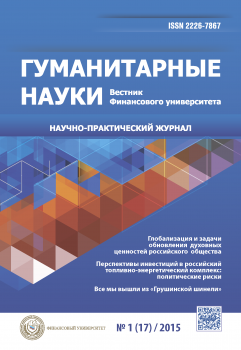Article is devoted to reflection of the Soviet economic model and economic reform of 1965 in the western, in particular, Anglo- American Sovietology. The author briefly stops on the main maintenance of the Soviet economic reform of 1965 and its destiny and explains why this piece of the Soviet economic history I caused fixed interest of the western Sovietology. Describing researches of the western Sovietology, the author focuses attention of readers that real statistics of the Soviet economy, figures and events, were closed both for the western researcher, and for the ordinary Soviet inhabitant. Generally to works of the western Sovietology treated as intended falsification. Not all works of the western experts were equivalent. The most realistic picture displaying processes and the facts of the Soviet post-war economy is presented in works of emigrants from the USSR - I. Birman’s (Igor Birman) economists of A. Katsenelenbogen (Aron Katsenelinboigen). Their conclusions stated in scientific works could be sounded in the Soviet scientific literature only under a signature stamp of «the critic of bourgeois theories». The author specifies that the analysis of the Soviet economy was made by the western Sovietology generally from comparativistic perspective. In the course there were theories of «unsuccessful connection» (Ya. Kornai), «administrative economy» (R. Campbell), etc. In more detail the author stops at works of A. Bergson who considers as the most qualified specialist who adequately displayed the Soviet economic reality of the 1960-70th. Speaking about success of works of A. Bergson, the author specifies that his works relied on broad financing within the project which was carried out by request of CIA. For many years the western Sovietology was considered a priori as intended falsification of the Soviet history. And only access to real figures and the facts of the Soviet economic reality of the post-war period allowed to estimate in a new way its analysis, scientific character and objectivity. The article is constructed on original historical material and can be interesting to a wide range of readers.
command-administrative model, direction, economic reform, management, concept, decision, plan, sovietology, theory.
Советской экономической реформе 1965 г., получившей название Косыгинской, в 2015 г. исполняется 50 лет. За прошедшие полвека историкам представилась возможность неоднократно оценить это масштабное явление, его замысел, содержание и последствия. Обратимся к фактам и исторической оценке.
Впервые основные идеи реформы были обнародованы в статье профессора Харьковского инженерно-экономического института и Харьковского государственного университета Е.Г. Либермана «План, прибыль, премия» в газете «Правда» (1962) и его докладе «О совершенствовании планирования и материального поощрения работы промышленных предприятий», направленном в ЦК КПСС. Статья положила начало общесоюзной экономической дискуссии в прессе и ряду экономических экспериментов, подтвердивших эффективность предложенных мероприятий. В западной прессе и советологии концепция реформ получила название «либерманизм».
Экономическая реформа 1960-х гг. была призвана возродить материальный интерес к производству, прежде всего в сельском хозяйстве. Были повышены закупочные цены на сельхозпродукцию, установлен твердый план и надбавки за его перевыполнение, увеличены капиталовложения в деревню. Реформировано управление промышленностью, введены меры экономического стимулирования (пленумы ЦК КПСС 1965 г.) — хозрасчет, отраслевое управление, увеличение местной инициативы и т.д. Полученные средства предполагалось использовать в строительстве новых промышленных предприятий, жилищном строительстве и вложениях в деревню. Но уже в 1970-е гг.
начинается спад. Реформа была потихоньку свернута, консервативная верхушка руководства покончила с остатками хозяйственной самостоятельности. О содержании реформы, ходе ее реализации, цифрах и результатах написано много, и можно продолжать исследование этого масштабного историко-экономического события в разных ракурсах достаточно долго.
Характерно, что в ходе проведения экономической реформы 1965 г. в СССР оживился интерес западных советологов к советской экономической модели. В 1960–1970 гг. появляются многие работы английских и американских авторов, которые, анализируя советскую действительность, на основании этого анализа создают новые теории, выдвигают собственные модели советской экономики [1]. Кроме того, в этот период появилось немало работ, посвященных конкретным фактам развития экономики СССР [2].
1. Abram B., Erlich A., Levine H.S., Nutter G.W., WelhszS., Roberts H.L. Soviet Economic Performance and Reform: Some Problems of Analysis and Prognosis. Slavic Review, 1966. Vol. 25. №2. P. 222-246.
2. Katsenelinboigen A. Conflicting Trends in Soviet Economics in the Post-Stalin Era. Russian Review, 1976. Vol. 35. № 4. P. 373-399.
3. Kudrow V.M. Krakh sovetskoy modeli ekonomiki [The collapse of the Soviet economic model]. Moscow, Moscow public science Foundation Publ., 2000. 223 p.
4. Havina S.A. Kritika burzhuaznykh vzglyadov na zakonomernosti sotsialisticheskogo khozyaystvovaniya [Critique of the bourgeois views of the laws of socialist economic management]. Moscow, 1968.
5. Kornai I. The Socialist System: The Political Economy of Socialism, Oxford, 1992.672 p.
6. Gershenkron A. Economic Backwardness in Historical Perspeсtives. Princeton, 1961.278 p.
7. Ellman M. The Fundamental Problem of Socialist Planning. Oxford Economic Papers, 1978. Vol. 30. № 2. P. 152-159.
8. Bergson A. The Economics of Soviet Planning. New Haven FF, 1964.411 p.
9. Nutter W. Growth of Industrial Production in the Soviet Union. Princeton, 1962. P. xxvii, 706.
10. Bergson A. Planning and Performance in Socialist Economies. Boston, 1989. 304 p.





